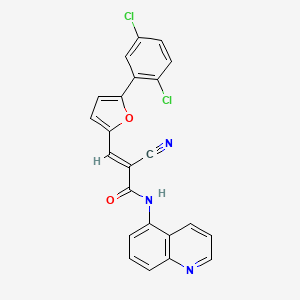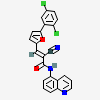Agk-2
- AGK2
- 304896-28-4
- AGK-2
- AGK 2
- UNII-DDF0L8606A
- Create:2005-07-10
- Modify:2025-01-18

- AGK2
- 304896-28-4
- AGK-2
- AGK 2
- UNII-DDF0L8606A
- DDF0L8606A
- 2-Propenamide, 2-cyano-3-(5-(2,5-dichlorophenyl)-2-furanyl)-N-5-quinolinyl-
- MFCD01909444
- CHEMBL224864
- 2-cyano-3-(5-(2,5-dichlorophenyl)furan-2-yl)-N-(quinolin-5-yl)acrylamide
- 2-Propenamide, 2-cyano-3-[5-(2,5-dichlorophenyl)-2-furanyl]-N-5-quinolinyl-
- SIRT2 Inhibitor, AGK2
- 2-cyano-3-[5-(2,5-dichlorophenyl)furan-2-yl]-N-(quinolin-5-yl)prop-2-enamide
- (E)-2-cyano-3-[5-(2,5-dichlorophenyl)furan-2-yl]-N-quinolin-5-ylprop-2-enamide
- DTXSID80184559
- AGK2?
- GTPL8099
- SCHEMBL1105117
- CHEBI:94578
- DTXCID101065268
- HMS3263O16
- HMS3648E10
- BCP07480
- EX-A2377
- SMSF0008624
- Tox21_501117
- BDBM50216689
- AGK2, >=97% (HPLC), powder
- AKOS001027725
- CB00136
- CCG-208656
- CS-7830
- LP01117
- SDCCGSBI-0633793.P001
- NCGC00186038-01
- NCGC00186038-12
- NCGC00261802-01
- AC-33104
- AS-73242
- HY-100578
- A3193
- EN300-40464
- C74569
- EN300-371830
- SR-02000000925
- J-017986
- SIRT2 Inhibitor, AGK2 - CAS 304896-28-4
- SR-02000000925-2
- BRD-K32536677-001-01-0
- Q27074346
- Z46080163
- (E)-2-Cyano-3-(5-(2,5-dichlorophenyl)furan-2-yl)-N-(quinolin-5-yl)acrylamide
- (2E)-2-CYANO-3-[5-(2,5-DICHLOROPHENYL)FURAN-2-YL]-N-(QUINOLIN-5-YL)PROP-2-ENAMIDE
- 2711817-72-8

P264+P265, P280, P305+P351+P338, and P337+P317
(The corresponding statement to each P-code can be found at the GHS Classification page.)
Aggregated GHS information provided per 39 reports by companies from 2 notifications to the ECHA C&L Inventory.
Information may vary between notifications depending on impurities, additives, and other factors. The percentage value in parenthesis indicates the notified classification ratio from companies that provide hazard codes. Only hazard codes with percentage values above 10% are shown.
Patents are available for this chemical structure:
https://patentscope.wipo.int/search/en/result.jsf?inchikey=SVENPFFEMUOOGK-SDNWHVSQSA-N
- ChEBI2-cyano-3-[5-(2,5-dichlorophenyl)-2-furanyl]-N-(5-quinolinyl)-2-propenamidehttps://www.ebi.ac.uk/chebi/searchId.do?chebiId=CHEBI:94578
- ChEMBLLICENSEAccess to the web interface of ChEMBL is made under the EBI's Terms of Use (http://www.ebi.ac.uk/Information/termsofuse.html). The ChEMBL data is made available on a Creative Commons Attribution-Share Alike 3.0 Unported License (http://creativecommons.org/licenses/by-sa/3.0/).http://www.ebi.ac.uk/Information/termsofuse.htmlChEMBL Protein Target Treehttps://www.ebi.ac.uk/chembl/g/#browse/targets
- ChemIDplusChemIDplus Chemical Information Classificationhttps://pubchem.ncbi.nlm.nih.gov/source/ChemIDplus
- European Chemicals Agency (ECHA)LICENSEUse of the information, documents and data from the ECHA website is subject to the terms and conditions of this Legal Notice, and subject to other binding limitations provided for under applicable law, the information, documents and data made available on the ECHA website may be reproduced, distributed and/or used, totally or in part, for non-commercial purposes provided that ECHA is acknowledged as the source: "Source: European Chemicals Agency, http://echa.europa.eu/". Such acknowledgement must be included in each copy of the material. ECHA permits and encourages organisations and individuals to create links to the ECHA website under the following cumulative conditions: Links can only be made to webpages that provide a link to the Legal Notice page.https://echa.europa.eu/web/guest/legal-notice
- FDA Global Substance Registration System (GSRS)LICENSEUnless otherwise noted, the contents of the FDA website (www.fda.gov), both text and graphics, are not copyrighted. They are in the public domain and may be republished, reprinted and otherwise used freely by anyone without the need to obtain permission from FDA. Credit to the U.S. Food and Drug Administration as the source is appreciated but not required.https://www.fda.gov/about-fda/about-website/website-policies#linking
- Comparative Toxicogenomics Database (CTD)LICENSEIt is to be used only for research and educational purposes. Any reproduction or use for commercial purpose is prohibited without the prior express written permission of NC State University.http://ctdbase.org/about/legal.jspAGK2 compoundhttps://ctdbase.org/detail.go?type=chem&acc=C521855
- IUPHAR/BPS Guide to PHARMACOLOGYLICENSEThe Guide to PHARMACOLOGY database is licensed under the Open Data Commons Open Database License (ODbL) https://opendatacommons.org/licenses/odbl/. Its contents are licensed under a Creative Commons Attribution-ShareAlike 4.0 International License (http://creativecommons.org/licenses/by-sa/4.0/)https://www.guidetopharmacology.org/about.jsp#licenseGuide to Pharmacology Target Classificationhttps://www.guidetopharmacology.org/targets.jsp
- Therapeutic Target Database (TTD)
- Japan Chemical Substance Dictionary (Nikkaji)
- Wikidata
- PubChem
- GHS Classification (UNECE)GHS Classification Treehttp://www.unece.org/trans/danger/publi/ghs/ghs_welcome_e.html
- MolGenieMolGenie Organic Chemistry Ontologyhttps://github.com/MolGenie/ontology/
- PATENTSCOPE (WIPO)SID 391296364https://pubchem.ncbi.nlm.nih.gov/substance/391296364

